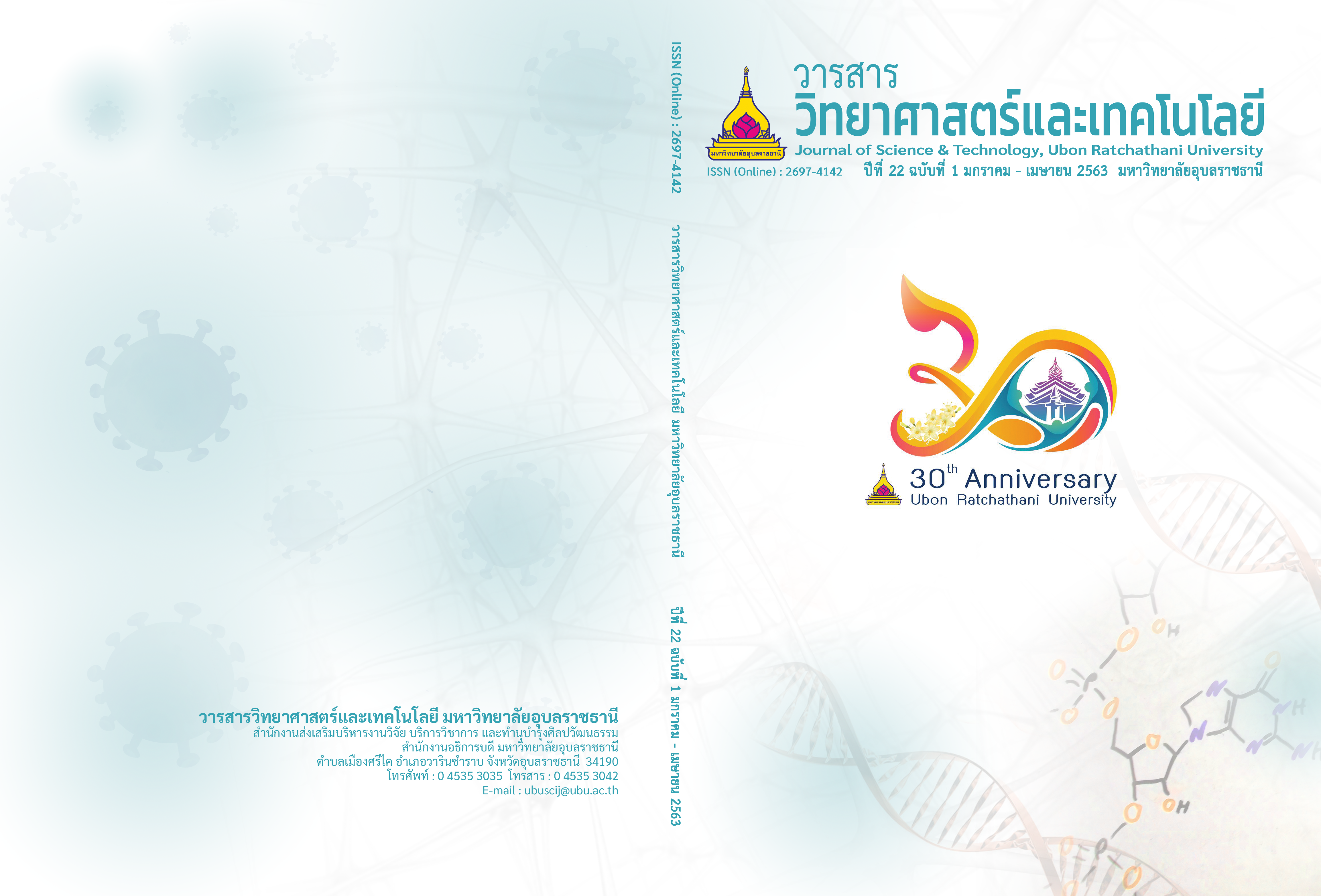คุณสมบัติทางกายภาพ คุณสมบัติทางกล และคุณสมบัติในการต้านเชื้อราของฟิล์มพลาสติกชีวภาพ PLA ผสมน้ำมันหอมระเหยจากจำปีบนข้าวกล้อง
Main Article Content
บทคัดย่อ
งานวิจัยนี้มีจุดประสงค์เพื่อศึกษาคุณสมบัติทางกายภาพ (การต้านทานการเปียก สี และลักษณะพื้นผิวของแผ่นฟิล์ม) คุณลักษณะทางกล (ค่าความต้านทานแรงดึง ความยืดหยุ่น การยืดตัว ณ จุด ขาด) และคุณสมบัติในการต้านเชื้อราของฟิล์มพลาสติกชีวภาพ PLA (Polylactic acide) ผสมกับน้ำมันหอมระเหยจากจำปีที่ความเข้มข้น 0 (ชุดควบคุม) ถึง 0.3 เปอร์เซ็นต์ในการยับยั้งเชื้อรา Aspergillus flavus เชื้อรา Aspergillus niger และเชื้อรา Penicillium chrysogenum และเชื้อราธรรมชาติบนข้าวกล้อง จากนั้นจึงทำการทดสอบการยอมรับต่อกลิ่นรสทางประสาทสัมผัสโดยใช้ 9 - Point hedonic scale ผลการศึกษาพบว่าเมื่อเพิ่มความเข้มข้นของน้ำมันหอมระเหยจากจำปีในฟิล์ม PLA ทำให้แผ่นพลาสติกมีค่าความยืดหยุ่น การยืดตัว ณ จุดขาด ความต้านทานต่อแรงดึงและความสว่างลดต่ำลง แต่มีค่าความเป็นสีเหลืองและความสามารถในการต้านทานการเปียกน้ำได้ดีขึ้น (P<0.05) ฟิล์ม PLA ที่ผสมน้ำมันหอมระเหยจากจำปีที่ความเข้มข้น 0.3 เปอร์เซ็นต์ สามารถลดการเจริญเติบโตของเชื้อรา A. flavus เชื้อรา A. niger และ P. chrysogenum บนข้าวกล้องได้ประมาณ 1.2-1.6 Log 10 CFU g-1 และลดเชื้อราตามธรรมชาติในข้าวกล้องได้ประมาณ 1.45 Log 10 CFU g-1 นอกจากนั้นยังพบว่าผู้บริโภคให้คะแนนการยอมรับต่อคุณลักษณะทางประสาทสัมผัสของข้าวกล้องที่เก็บรักษาโดยใช้ฟิล์ม PLA ที่มีน้ำมันหอมระเหยตั้งแต่ 0.1 ถึง 0.5 เปอร์เซ็นต์ไม่แตกต่างจากข้าวกล้องหุงสุกชุดควบคุม (P<0.05) โดยเฉพาะคะแนนด้านสี กลิ่น รสชาติและเนื้อสัมผัส ดังนั้นพลาสติกชีวภาพ PLA ที่มีน้ำมันหอมระเหยจากจำปีมีแนวโน้มในการนำมาใช้ป้องกันการเจริญของเชื้อราบนข้าวกล้องได้และวิธีการนี้อาจช่วยทำให้ข้าวกล้องเป็นที่ยอมรับของผู้บริโภคมากขึ้น
Article Details
บทความที่ได้รับการตีพิมพ์เป็นลิขสิทธิ์ของ วารสารวิทยาศาสตร์และเทคโนโลยี มหาวิทยาลัยอุบลราชธานี
ข้อความที่ปรากฏในบทความแต่ละเรื่องในวารสารวิชาการเล่มนี้เป็นความคิดเห็นส่วนตัวของผู้เขียนแต่ละท่านไม่เกี่ยวข้องกับมหาวิทยาลัยอุบลราชธานี และคณาจารย์ท่านอื่นๆในมหาวิทยาลัยฯ แต่อย่างใด ความรับผิดชอบองค์ประกอบทั้งหมดของบทความแต่ละเรื่องเป็นของผู้เขียนแต่ละท่าน หากมีความผิดพลาดใดๆ ผู้เขียนแต่ละท่านจะรับผิดชอบบทความของตนเองแต่ผู้เดียว
เอกสารอ้างอิง
[2] Ding, C. and et al. 2015. “Improvement in shelf life of rough and brown rice using infrared radiation heating”. Food and Bioprocess Technology. 8(5): 1149-1159.
[3] Lai, X. and et al. 2015. “Potential for aflatoxin B1 and B2 production by Aspergillus flavus strains isolated from rice samples”. Saudi journal of biological sciences. 22(2): 176-180.
[4] González, A., & Igarzabal, C. I. A. 2013. “Soy protein – Poly (lactic acid) bilayer films as biodegradable material for active food packaging”. Food Hydrocolloids. 33(2): 289-296.
[5] Qiu, Z., Gao, Q. and Bao, J. 2017. “Constructing xylose-assimilating pathways in Pediococcus acidilactici for high titer d-lactic acid fermentation from corn stover feedstock,” Bioresource Technology. 245: 1369-1376.
[6] Lv, S. and et al. 2018. “Physicochemical evolutions of starch/poly (lactic acid) composite biodegraded in real soil”. Journal of Environmental Management. 228; 223-231.
[7] Songsamoe, S., Matan, N. and Matan, N. 2017. “Antifungal activity of Michelia alba oil in the vapor phase and the synergistic effect of major essential oil components against Aspergillus flavus on brown rice”. Food Control. 77: 150-157.
[8] Suhem, K. and et al. 2017. “Enhanced antifungal activity of michelia oil on the surface of bamboo paper packaging boxes using helium-neon (HeNe) laser and its application to brown rice snack bar”. Food Control. 73: 939-945.
[9]. Noysang, C. and et al. 2014. “Cytotoxicity and inhibition of P-glycoprotein by selected medicinal plants from Thailand”. Journal of Ethnopharmacology. 155: 633-641.
[10] Samakradhamrongthai, R. and et al. 2015. “Encapsulation of Michelia alba DC extract using spray drying and freeze drying and application on Thai dessert from rice flour”. International Journal of Food Engineering 1(2): 77-85.
[11] Arrieta, M. P. and et al. 2013. “Characterization of PLA-limonene blends for food packaging applications”. Polymer Testing. 32(4): 760-768.
[12] Wen, P. and et al. 2016. “Fabrication of electrospun polylactic acid nanofilm incorporating cinnamon essential oil/β-cyclodextrin inclusion complex for antimicrobial packaging”. Food chemistry. 196: 996-1004.
[13] Javidi, Z., Hosseini, S. F. and Rezaei, M. 2016. “Development of flexible bactericidal films based on poly (lactic acid) and essential oil and its effectiveness to reduce microbial growth of refrigerated rainbow trout”. LWT-Food Science and Technology. 72: 251-260.
[14] Sánchez-González, L. and et al. 2010. “Physical and antimicrobial properties of chitosan–tea tree essential oil composite films”. Journal of Food Engineering. 98(4): 443-452.
[15] Qin, Y. and et al. 2017. “Development of active packaging film made from poly (lactic acid) incorporated essential oil”. Progress in Organic Coatings. 103: 76-82.


